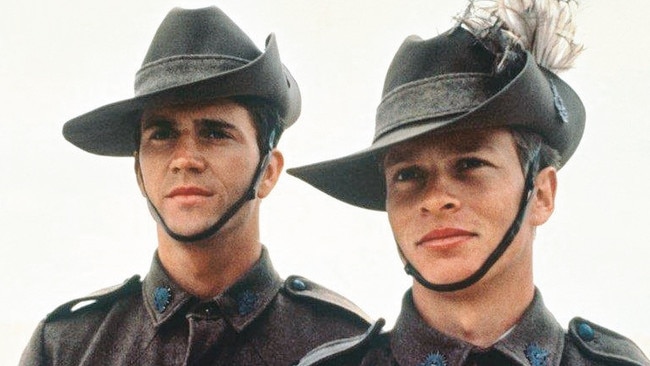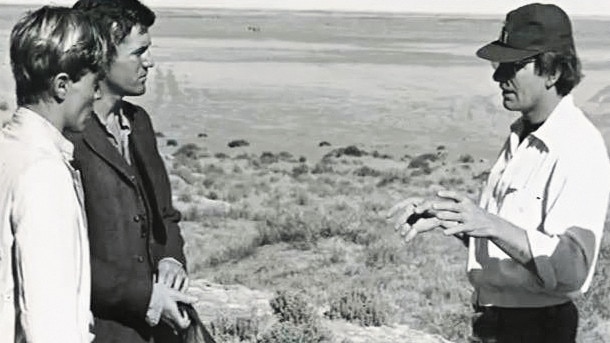Gallipoli actor Mark Lee reflects on the iconic film, 40 years on
Forty years after the release of the iconic Australian war film, leading man Mark Lee talks about the moment he realised he was part of movie-making magic with fellow actor Mel Gibson, and remembers the poignant day he finally visited the site of the battle.
Stellar
Don't miss out on the headlines from Stellar. Followed categories will be added to My News.
It wasn’t until six weeks after they had started filming that the filmmakers realised they were doing something special. A typical Australian film would have already wrapped by then. But this was no typical Australian film.
It was Gallipoli, regarded by many as the greatest Australian movie ever made, and a harrowing portrait of war that’s been indelibly burned into the minds of generations of schoolchildren.

Yet for most of the cast and crew – even leading man Mark Lee – it started out as just another job. Certainly, it was a big job – with a budget of almost $3 million, it was the most expensive Australian film ever made at the time, and the 12-week shoot was twice as long as most productions here. Lee also had as his co-star an ambitious young actor by the name of Mel Gibson.
Now, 40 years on, Gibson is a Hollywood superstar and Academy Award-winning filmmaker who has been beset by scandal and alcohol addiction. But 62-year-old Lee is still as down-to-earth, easygoing and baby-faced as the innocent soldier he played in Australian director Peter Weir’s cinematic masterpiece.
“I don’t know, it’s hard to put a finger on it,” Lee tells Stellar, when asked about the film’s incredible legacy. Perhaps that’s because its lingering influence is still felt throughout Australia – and by all Australians.

“I once went to a screening as a request of a small country school,” Lee says. “A friend
of mine’s parents taught there and said, ‘Would you come up?’ And I thought, bugger it, yeah – why not? And at the screening there were four generations of people who knew the film, from the grandmother to the father to the son to the great-grandson. I thought, oh, that’s interesting.”
But those working on the 1981 film were quite unaware of the profundity of what they were doing, and the impact it would have – or at least they were until the tuna fishermen came along.
“[We didn’t realise its impact] until we hit Port Lincoln, where we ended [the shoot],” Lee recalls. Due to the way the film was budgeted, Gallipoli was shot in chronological order, a process that was highly unusual, and which meant the cast and crew were watching the rough cuts of the film in the same order that audiences would later see the finished product.
And so the shores of Port Lincoln in South Australia became Anzac Cove in Gallipoli, Turkey, where the film would reach its fatal climax.

“We were halfway through [filming], and a lot of tuna fishermen – because the tuna fishing season had run its season and the factories had closed down [so] the guys were out of work – suddenly got this job for six weeks, where they were making good money playing extras.”
Back then, the director had to wait for the rushes to be processed and couriered back on 35mm film, and then played in the production office on a reel-to-reel projector. “The tuna fishermen – the extras – started creeping into the office. And they were really quiet, so the production company didn’t say anything,” Lee tells Stellar.
“Slowly, more and more started to appear, until finally it got packed out. I remember even Peter Weir had trouble getting a seat one night because it was packed with all these country guys with sixpacks [of beer].”

The blokes from the bush sensed the magic of the film even before those making it fully did. At first they’d cheer their characters on and ask for endless replays. But then came the final scene.
“When we started shooting the final sequences, the final battle, it was interesting – the party atmosphere dissipated, and some of the biggest, hardest men there...
I saw one of them weeping one night,” Lee recounts. “At that point, we realised maybe this will affect people.”
That could be the understatement of the century because the final scene of Gallipoli is something you never, ever forget. And, indeed, anyone who hasn’t seen it should stop reading now.
While the movie was both shot and seen from beginning to end, it’s really a story that starts with an ending and then takes its fated characters inexorably towards it.

That ending is, of course, the gunning down of Lee’s bright-eyed character Archy during an utterly pointless offensive seconds before his more worldly best friend Frank (Gibson) arrives with orders to abort the charge.
As Gibson has said, it’s not so much a film about war but a film about friendship with war as a backdrop. In fact, in an early version of the script, there was to be no war at all, and Archy was to be shot dead before he even stepped off the troopship. Because this was always a film about loss; about the preciousness of life and the carelessness with which it’s so often taken.
It’s perhaps also symbolic of the death of Australian innocence on that shore in 1915. Gone is Archy, the wide-eyed farmer’s son from the outback, while Frank, the cynical immigrant’s son from the city, goes on.

Likewise, Gibson went on to become one of Hollywood’s biggest stars, with all the messiness that followed, while Lee still lives in suburban Sydney with his wife Marianne, with whom he has two adult daughters, Romi and Katie. Still acting here and there, he’s the picture of contentment. Gibson, he says, was always different.
“[Mel] was always at the head of the game – he was leaps and bounds ahead with what he wanted to do. I’m still not sure what I want to do with my life!” he says, laughing.
One thing Lee did do, however, was visit the place where his most iconic character – inspired by a real-life young private called Wilfred Harper – fell. Standing on a narrow ridge called the “Nek” on the Gallipoli peninsula, he gazed across the land upon which Wilfred and so many others died.
And as he remembers that moment, Lee quietly says, “It was overwhelming.”





